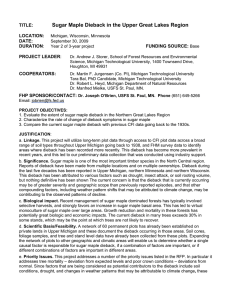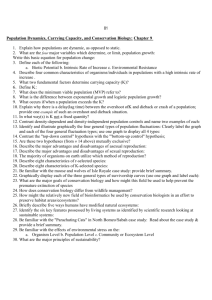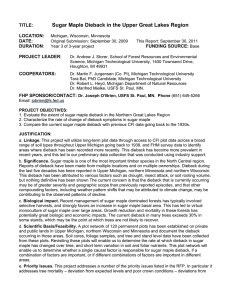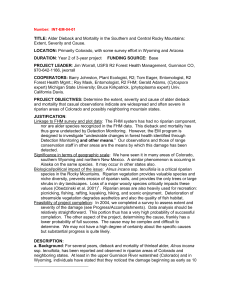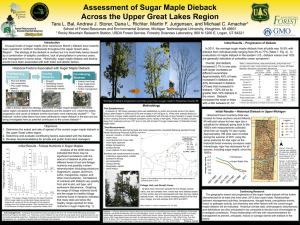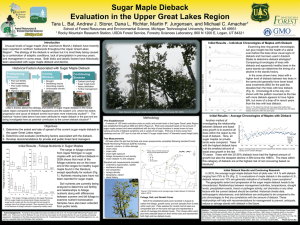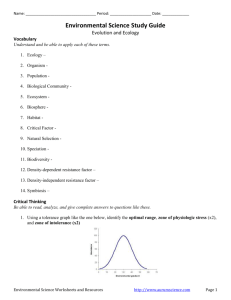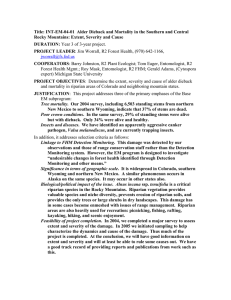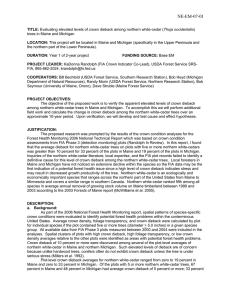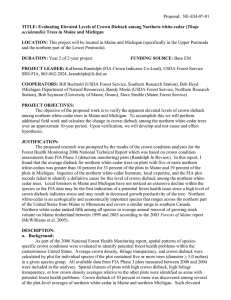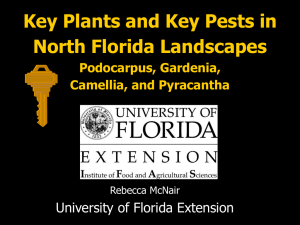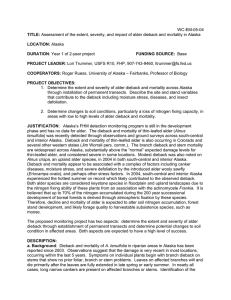Sugar Maple Dieback in the Upper Great Lakes Region TITLE: LOCATION:
advertisement
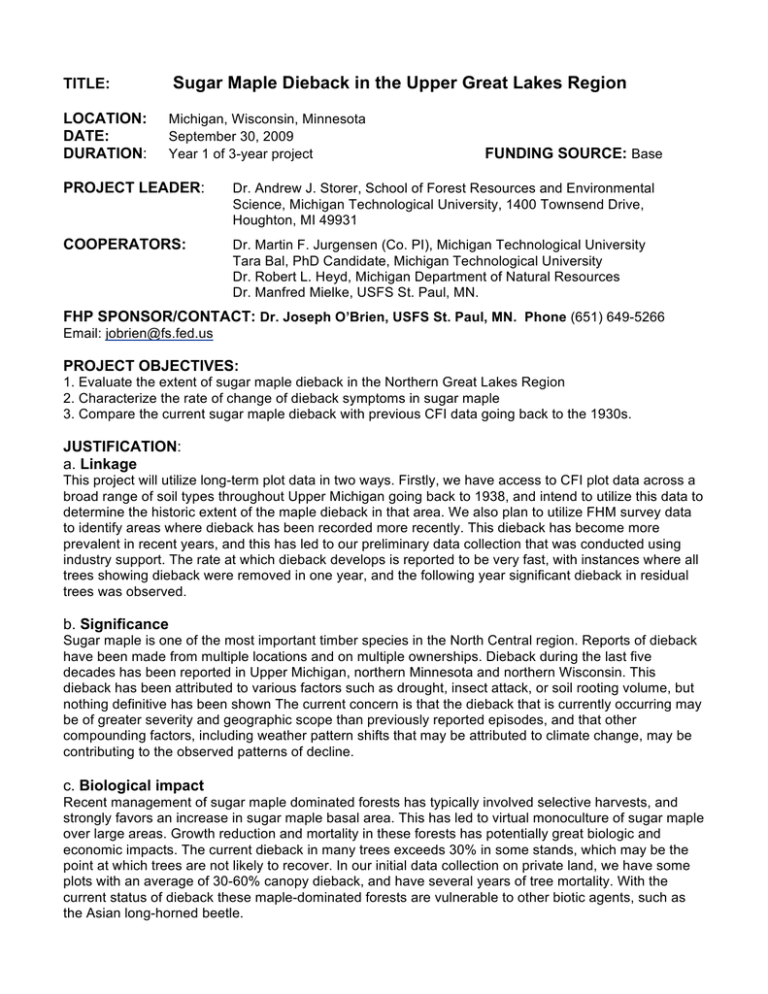
Sugar Maple Dieback in the Upper Great Lakes Region TITLE: LOCATION: DATE: DURATION: Michigan, Wisconsin, Minnesota September 30, 2009 Year 1 of 3-year project FUNDING SOURCE: Base PROJECT LEADER: Dr. Andrew J. Storer, School of Forest Resources and Environmental Science, Michigan Technological University, 1400 Townsend Drive, Houghton, MI 49931 COOPERATORS: Dr. Martin F. Jurgensen (Co. PI), Michigan Technological University Tara Bal, PhD Candidate, Michigan Technological University Dr. Robert L. Heyd, Michigan Department of Natural Resources Dr. Manfred Mielke, USFS St. Paul, MN. FHP SPONSOR/CONTACT: Dr. Joseph O’Brien, USFS St. Paul, MN. Phone (651) 649-5266 Email: jobrien@fs.fed.us PROJECT OBJECTIVES: 1. Evaluate the extent of sugar maple dieback in the Northern Great Lakes Region 2. Characterize the rate of change of dieback symptoms in sugar maple 3. Compare the current sugar maple dieback with previous CFI data going back to the 1930s. JUSTIFICATION: a. Linkage This project will utilize long-term plot data in two ways. Firstly, we have access to CFI plot data across a broad range of soil types throughout Upper Michigan going back to 1938, and intend to utilize this data to determine the historic extent of the maple dieback in that area. We also plan to utilize FHM survey data to identify areas where dieback has been recorded more recently. This dieback has become more prevalent in recent years, and this has led to our preliminary data collection that was conducted using industry support. The rate at which dieback develops is reported to be very fast, with instances where all trees showing dieback were removed in one year, and the following year significant dieback in residual trees was observed. b. Significance Sugar maple is one of the most important timber species in the North Central region. Reports of dieback have been made from multiple locations and on multiple ownerships. Dieback during the last five decades has been reported in Upper Michigan, northern Minnesota and northern Wisconsin. This dieback has been attributed to various factors such as drought, insect attack, or soil rooting volume, but nothing definitive has been shown The current concern is that the dieback that is currently occurring may be of greater severity and geographic scope than previously reported episodes, and that other compounding factors, including weather pattern shifts that may be attributed to climate change, may be contributing to the observed patterns of decline. c. Biological impact Recent management of sugar maple dominated forests has typically involved selective harvests, and strongly favors an increase in sugar maple basal area. This has led to virtual monoculture of sugar maple over large areas. Growth reduction and mortality in these forests has potentially great biologic and economic impacts. The current dieback in many trees exceeds 30% in some stands, which may be the point at which trees are not likely to recover. In our initial data collection on private land, we have some plots with an average of 30-60% canopy dieback, and have several years of tree mortality. With the current status of dieback these maple-dominated forests are vulnerable to other biotic agents, such as the Asian long-horned beetle. d. Scientific Basis/Feasibility A network of 60 permanent plots has already been established on private lands in Upper Michigan (Figure 1), and these document the dieback occurring in those areas. Soil cores, foliage samples, and tree and stand level data have already been collected from these plots. Expanding the network of plots to other geographic and climatic areas will enable us to determine whether a single causal factor is responsible for sugar maple dieback, if a combination of factors are important, or if different combinations of factors are important in different areas. Figure 1: Distribution of existing plot network in northwestern Upper Michigan and national forest land (grey). The proposed work will expand this plot network to include federal land in Michigan and neighboring states. e. Priority Issues This project addresses a number of the priority issues listed in the RFP. In particular it addresses tree mortality – deviation from expected levels and poor crown conditions – deviations from normal. Since factors that are being considered as potential contributors to the dieback include soil conditions, drought, and changes in weather patterns that may be attributable to climate change, these priority issues are also being addressed. DESCRIPTION: a. Background: Major maple mortality events have occurred in pockets in various locations and extents throughout the 20th century. Largest amounts of mortality occurred in the 50’s and 60’s in the northern Great Lakes region, and were generally attributed to drought, pathogens, and past cutting practices. Other events in the eastern U.S. in the 70’s and 80’s were mostly attributed to air pollution and insect defoliation. Recently, unusual levels of dieback of sugar maple have been reported in the western Upper Peninsula of Michigan and other areas in the North Central region. The extent to which this dieback is related to management activities and to abiotic or biotic factors is unclear. In some areas where entries for harvests have been made, high proportions of the residual stand of crop trees have significant dieback and mortality. This dieback is sufficiently developed that it is clearly visible even during the winter months due to the loss of bark from branches in the upper canopy. Examining tree ring growth chronologies can give insight into the health of a stand before the trees show visual signs of dieback. Comparing chronologies of damaged trees with healthy ones or other tree species in a stand can show the spatial extent and timing of a decline. Insect defoliations, historical climatic data, anthropogenic disturbances, and other factors can be compared to the tree ring chronologies to assess which events are related to dieback. b. Methods: Our proposed work will expand our current network of 60 evaluation plots to add an additional 60 plots on national forest land in Upper Michigan, Northern Wisconsin and Minnesota. We will work with National Forest staff and Forest Health Monitoring to identify areas with and without significant levels of dieback, and use historical CFI data to identify where dieback has been documented in the past. Plots will be established following the protocols we have used on private land in our current project. Each tree in a 1/10 acre plot is measured and undergoes full canopy assessments. In addition, winter leaf-off assessments are made of dieback based on missing fine twigs and recent mortality of branches. Understory and regeneration subplots are included within the plot. Foliage samples are collected for nutrient analysis in August (summer conditions) and October (fall conditions) from trees with high, intermediate and low dieback. Biotic factors impacting the vigor of trees are assessed, including sugar maple borer, cankers, and sap streak disease. In addition, soil samples are collected from beneath healthy and dieback trees, and analyzed for carbon content, total nitrogen, available cations, and pH. Tree cores are taken from healthy and trees with differing levels of dieback, and processed on a growthring analyzer to calculate the relative effect of dieback on tree radial growth. c. Products: We anticipate completing peer-reviewed papers describing our findings, and developing guidelines for management of sugar maple in areas where dieback is present. In addition, we will contribute poster and oral presentations at meetings attended by stake-holders, including the annual Forest Health Working Group Meeting. By comparing our data with that from CFI plots dating back to 1938, we will be able to compare the current dieback event with ones that have occurred in the past in the Upper Peninsula of Michigan. d. Schedule of Activities: Spring/Summer 2010 Fall Winter 2010-11 Spring/Summer 2011 Fall/Winter 2011-12 Spring/Summer 2012 Fall/Winter 2012-2013 Establish plots on forest service land. Work with FHM and national forests to identify areas where dieback has been reported. Process soil and foliage samples. Winter data collection. Visit sites identified as having had dieback in CFI plots dating back to 1938. Assess canopies of trees in plots Complete processing of soil and foliage samples. Initial data analysis to identify data gaps Revisit plots for canopy assessments and change in dieback and to collect data to fill data gaps (e.g. additional soil samples if needed) Complete analysis of data and prepare manuscripts. In addition to this data collection, we anticipate having funding from other sources to continue to evaluate the plots currently established on industry land. However, this project is not dependent on having industry sponsorship. e. Progress/Accomplishments: NA COSTS: Item Personnel and fringes Supplies Travel Services Overhead (10%) Total Year 1 FHM 40,563 2000 5982 6000 5,455 60,000 Year 1 MTU 9,269 29,643 38,912 Year 2 FHM 40,563 2000 5982 6000 5,455 60,000 Year 2 MTU 9,269 29,643 38,912 Year 3 FHM 40,563 2000 5982 6000 5,455 60,000 Year 3 MTU 9,269 29,643 38,912 Personnel: 1 PhD student, faculty summer support and undergraduate field assistants. Supplies include those for the fieldwork and sampling. Services include soil and foliage analysis. Travel covers travel to field sites and travel to the annual FMH Work Group Meeting. Overhead is calculated at 10% and remainder of the 55% overhead is offered as costshare, along with faculty academic year salary. More than 50% of the work described in this proposal will take place on federal land, and hence the costshare proposed is less than 1:1.
